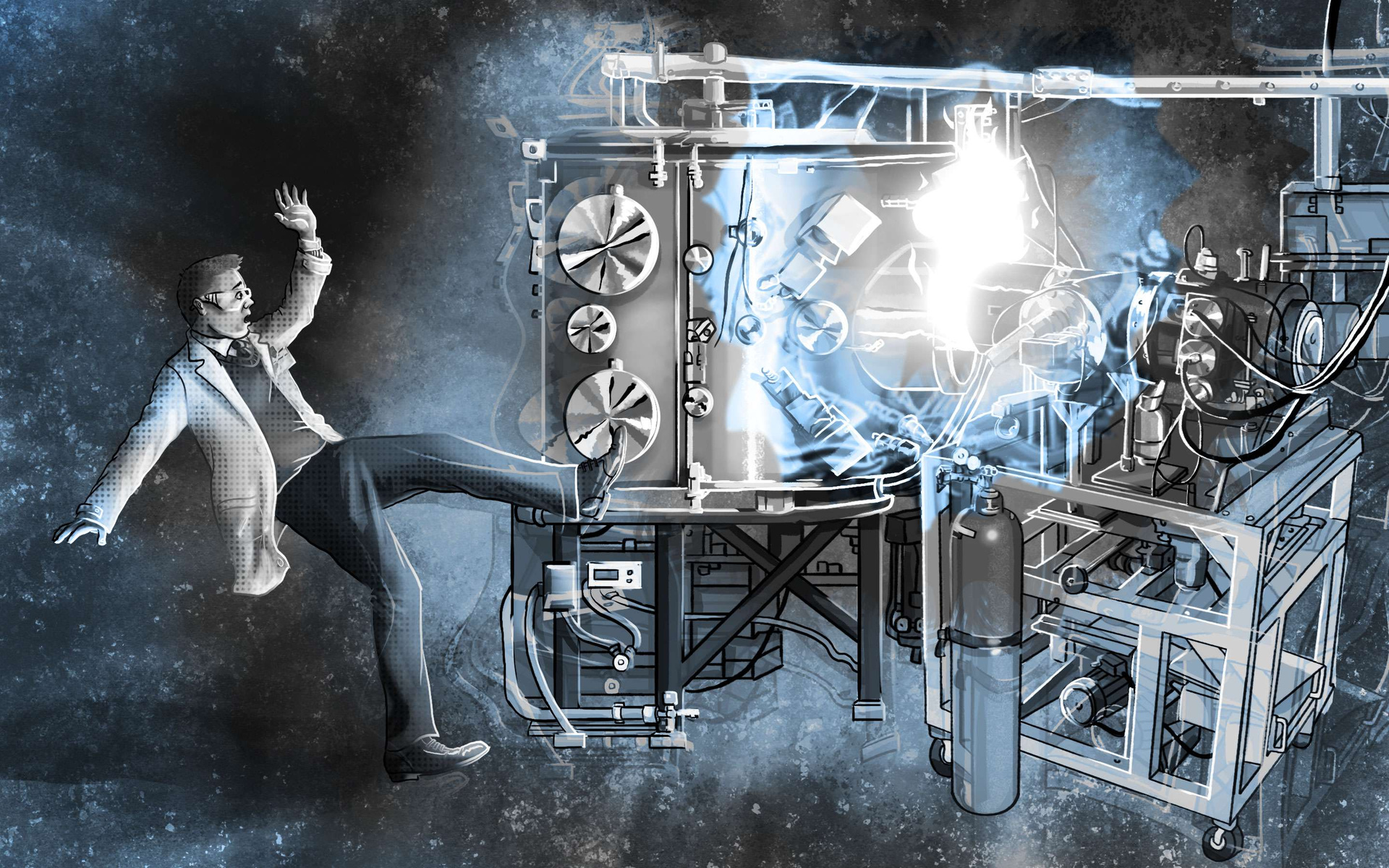 Illustration of Joanna Eberts (Joanna Eberts)
Illustration of Joanna Eberts (Joanna Eberts)Unfortunately, NucInc is not a new startup in the field of high nuclear technologies, which tomorrow will give us free electricity for all planned electric cars. These are abbreviations for nuclear incidents or nuclear incidents that have occurred too often over the past decade across the ocean.
I will ask you not to open up nervous and highly impressionable ones, but if you are ready for the fact that a nuclear apocalypse can start at any moment, not with a nuclear strike, but for ordinary human stupidity, then you are welcome under cat.
Recently, Science Magazine published two of
a series of articles published by the Center for Public Integrity. In total, the series contains five large articles that openly discuss current security issues at US nuclear facilities. Three of them today I will try to squeeze into one and, perhaps, answer the question: how did the technology citadel come to the stage that it cannot actually handle radioactive / fissile materials in a competent and safe way?
History reference
The Los Alamos National Laboratory (English Los Alamos National Laboratory, LANL) is one of the sixteen national laboratories of the US Department of Energy. At the time of the Manhattan Project, it was built in the mountains of New Mexico that are far from civilization.
 Los Alamos laboratory bird's-eye view. Photo: Wiki
Los Alamos laboratory bird's-eye view. Photo: WikiSimilarly, the Los Alamos and Livermore National Laboratories are the two leading organizations in the development, use, storage, and proper handling of nuclear weapons in the United States. Naturally, the Los Alamos complex consists of many buildings and laboratories. One of them, PF-4 (or Plutonium Facility-4), is a unique “workshop” where engineers process weapons-grade plutonium and test charges for an American nuclear shield. That is, they actually work with plutonium at all levels.
Part one. Incidents at nuclear facilities: happened and prevented
"Critical incident" or the last drop
In 2011, an incident occurred in the PF-4 laboratory of the nuclear complex at Los Alamos, which nearly led to another disaster. One unfortunate engineer without adequate access to the glove box or
glove-box (a special chamber that prevents the spread of particles of radioactive materials, dust) laid out plutonium rods in it for a beautiful photo. LANL has its own
Flickr channel , including with photos of works in such glove-boxes, so “posturing” is not such a rarity.
However, the mass of radioactive materials located for a photo shoot against the background of a “dangerous” black and yellow ribbon exceeded the maximum permissible limit by a quarter. The critical mass of
239 Pu is only 11 kg, which is equivalent to a ball with a diameter of ~ 10 cm (in fact, a little less than the length of the handle in the image below).
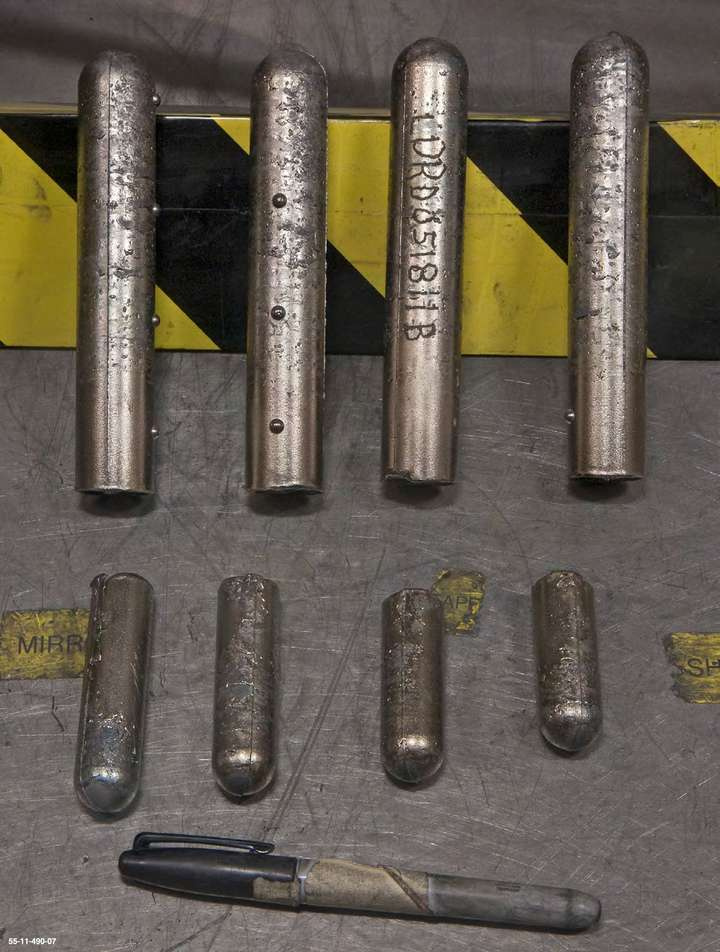 Eight plutonium rods in fatal proximity to each other: a little more material or a neutron moderator and a chain reaction would be triggered. Photo: Los Alamos National Laboratory / US Department of Energy
Eight plutonium rods in fatal proximity to each other: a little more material or a neutron moderator and a chain reaction would be triggered. Photo: Los Alamos National Laboratory / US Department of EnergyOf course, the sensors and monitoring systems worked instantly. The severity of the incident is indicated by the fact that the security chief of the entire complex at Los Alamos was called to the scene and a special team in chemical protection suits, which prevented the incident and smashed the rods to a safe distance. As it turned out later during the test and “debriefing”, the location of the rods was such that careless movement, an additional neutron-reflecting element (even just a human body, which is 90% composed of water that slows down neutrons), and ... a bright flash of attracting bluish Cherenkov radiation would almost instantly kill all the engineers in the room.
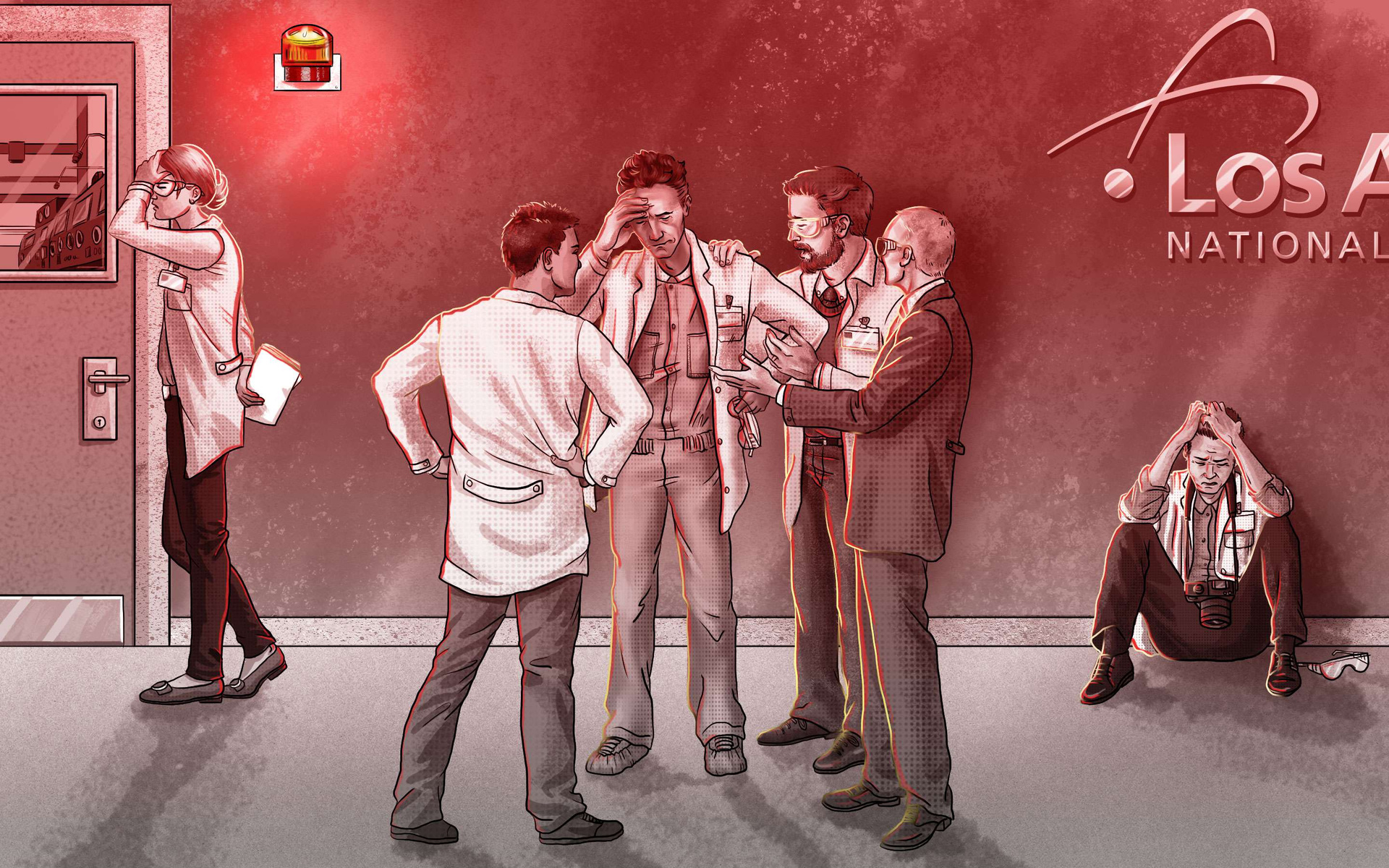 Oil painting: discouraged scientists at the door of the PF-4 lab, where a nuclear incident just happened. Illustration by Joanna Eberts (Joanna Eberts)
Oil painting: discouraged scientists at the door of the PF-4 lab, where a nuclear incident just happened. Illustration by Joanna Eberts (Joanna Eberts)As a result of strengthening security measures and updating the instructions for handling radioactive materials, where this incident was named “the most severe” in recent years, 12 out of 14 main engineers left the laboratory within a year and a half. Notice, the staff was simply forced to comply with security measures at a high-risk facility! This and other subsequent safety issues at the facility caused the process to stop for almost four years with short interruptions. Perhaps the problems of the laboratory and the entire complex at Los Alamos were
among the reasons NASA did not have enough plutonium for spacecraft.
C'est l'histoire qui se répète? (fr: history repeats itself?)
Here the curious reader will probably ask the question:
was the incident a coincidence and / or negligence from ignorance?Absolutely excluded. Both in the practice of Los Alamos itself, and in the world practice of such cases is complete. It is highly unlikely that engineers allowed to handle fissile materials were not told about them.
For example, in Los Alamos itself for half a century, three scientists lost their lives from radiation sickness for several days, and many received almost fatal doses in the blink of an eye, when the fatal coincidence of circumstances triggered a nuclear chain reaction while working with plutonium. Whether these cases were negligence, hope for "maybe" or an unforeseen accident when performing experiments is no longer important, it is important that the amount of fissile material per unit volume exceeded a certain critical level. This is what engineers should never forget.
First, in the mid-1940s, Harry Daghlian and
Louis Slotin died during operations with critical masses of plutonium under similar experimental conditions. The tragedy of Slotina, for example, is described
here . Their fate was repeated 12 years later by Cecil Kelley (
Cecil Kelley ), who “prepared” an overly concentrated plutonium solution. Apparently, he did not know that the tank contained the remnants of plutonium from past experiments and did not additionally check it. After a bright blue flash, he ran out into the corridor, shouting "I'm on fire!"
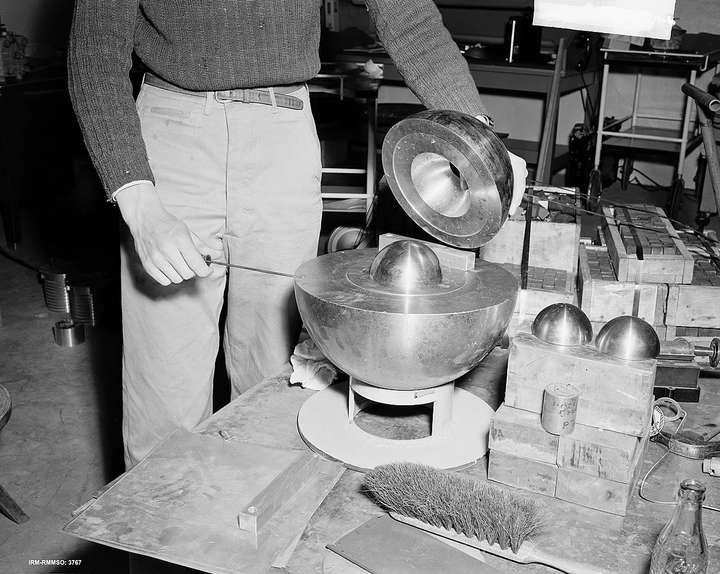 The ill-fated screwdriver and two hemispheres with which Slotin conducted experiments. Source: LANL
The ill-fated screwdriver and two hemispheres with which Slotin conducted experiments. Source: LANLA similar incident occurred in Japan 70 km from Tokyo’s multi-million dollar in 1999, when one of the workers did not cope with the dosage of enriched uranium powder and launched an uncontrolled chain reaction. Consequences: two received lethal doses, 120 people had to be evacuated, and 310,000 people had to hide in bunkers for some time. Japanese mini-Chernobyl, which happened long before Fukushima.
The course of radiation sickness of one of the Japanese workers (18+) In the hospital, 40 photographs were taken of a worker, Masato Shinohara, before he died a few months after the incident.
In the hospital, 40 photographs were taken of a worker, Masato Shinohara, before he died a few months after the incident. Part two. What is wrong with the laboratory in Los Alamos?
Sabotage or complete disregard for safety rules?
Official reports are replete with quite a rigid expression to the management of not only the laboratory PF-4, but the entire complex of the national laboratory in Los Alamos. On the same site
Science Magazine there is a tape with excerpts from such reports, which vary from a veiled "incredulous" (incredulous) to "crisis in the selection of personnel" (staffing in crisis) and "disaster" (disaster).
The last 4 years, the work of this laboratory has been resumed several dozen times, however, something happened time after time, someone was wrong, an incident occurred, and the premises were closed for weeks and months. As noted above, the main task of the laboratory is testing of warheads for “professional suitability”. Of the nearly three dozen warheads planned for analysis and testing, the staff did not complete the full cycle on any product. And this is despite the fact that Obama and Trump promised and fairly invested in the modernization of the American nuclear potential with a
ruble dollar.
Plus, with the arrival of private companies in this highly profitable business, the situation has only gotten worse. Naturally, private companies somewhere try to hush up incidents, somewhere problems happen because of too much pressure from management on the engineers-physicists and laboratory personnel when they are forced to perform work in a short time under the threat of deprivation of bonuses. For example, one of the glove-box, in which work with plutonium should be carried out, was damaged in a collision with a trolley, precisely because of mass haste. No wonder that the latest plutonium incident is dated March of this year.
As the Center’s articles on honesty in society tell us, safety regulations in a nuclear laboratory violate everything from engineer physicists to managers who can’t or don’t want to implement clear and clear rules for TB.
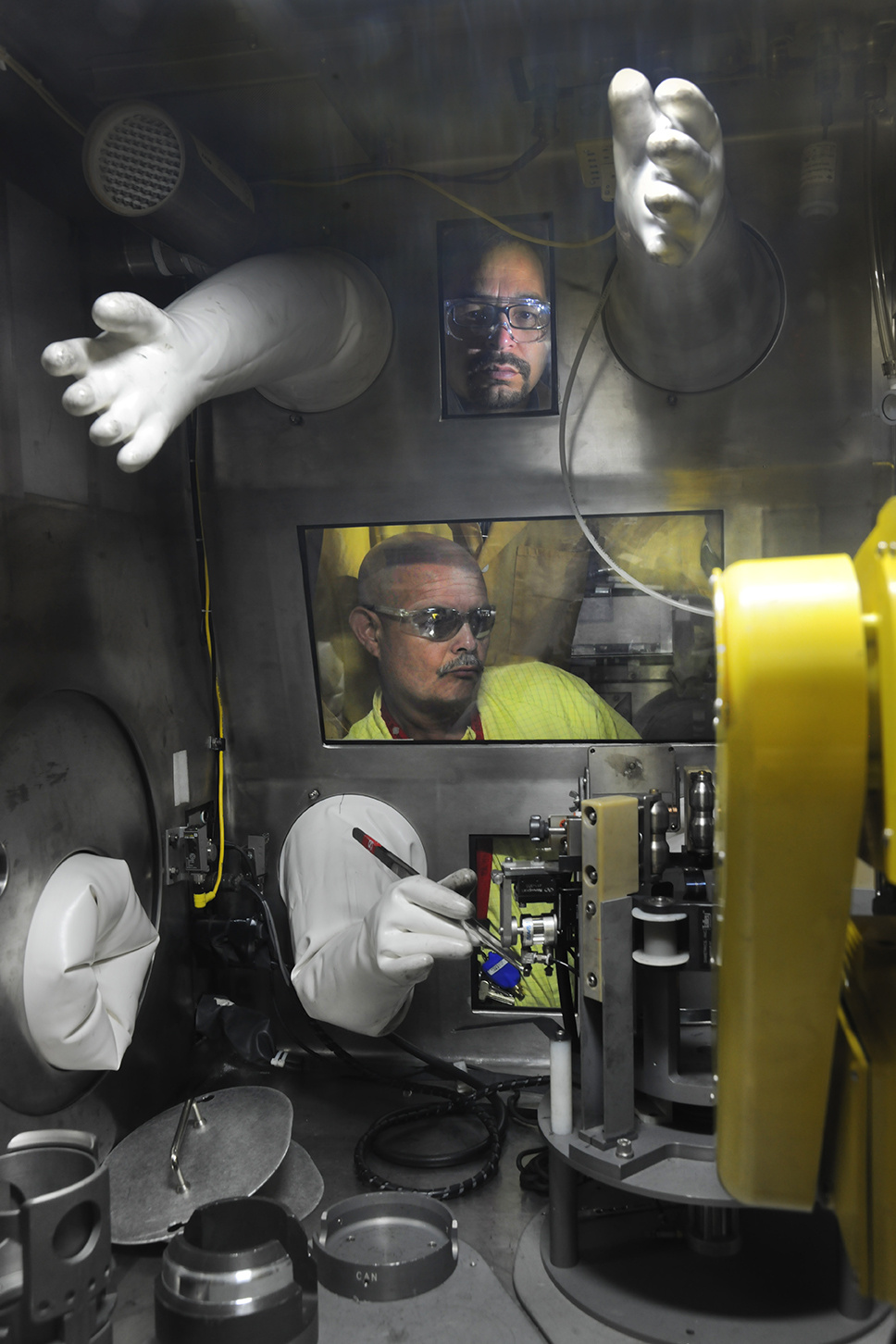 Engineers at work in the glove-box. Flickr lanl
Engineers at work in the glove-box. Flickr lanlWashington's Market Economy and Official Position
Los Alamos at the moment is unique not only from a scientific point of view, but also from a socio-economic one. One would assume that the US government does not allocate sufficient sums, both for training and for the operation itself. However, it is not. The unfortunate PF-4 laboratory consumes tens and millions of dollars of American taxpayers per year. Private companies that are involved in the work, and specialized universities consistently receive funding from the US Congress, with net (!) Profits of $ 10-15 million a year. Excellent profit, given that most of the time the laboratory is idle.
Among the reasons for downtime and the inability to start the work in full, the authors of the report mention the following:
- insufficient third-party control, because independent and / or federal officials in the positions of security managers are methodically replaced by more loyal people;
- the arrogance of private companies that are more likely to pursue profits per unit of time, rather than trying to do the job qualitatively and safely;
- literally, tiny sanctions in the event of incidents (i.e. no whip);
- poorly trained and / or unwilling to comply with safety personnel.
Below are the revenues of the laboratories involved in the US nuclear “business,” the lion’s share is received by private owners. In this case, the elimination of errors and incidents mainly involved in the federal government. Each leak or incident bypasses the budget in a tidy sum - up to several million dollars, depending on the complexity. However, the penalties for nuclear incidents and non-compliance with safety regulations compared to earnings - mere pennies, tens of thousands of dollars. It is noteworthy that attempts to replace one company with another fail: jur. faces change, but the situation remains the same.
 Net income over the past 10 years, the main national laboratories in the US working with fissile materials. The average annual income in some places exceeds $ 50 million
Net income over the past 10 years, the main national laboratories in the US working with fissile materials. The average annual income in some places exceeds $ 50 millionWhile official Washington is trying to sue the contractors for half a million dollars for deadlines, calling specialists to the scene of incidents and regular (almost quarterly) audits, the US Department of Energy is pouring in millions and millions of the same dollars to maintain infrastructure and protect personnel . At the same time, the Trump administration announced a $ 1.6 billion (
!!! ) program to “renovate” nuclear weapons, in which the Los Alamos laboratory will play the main role, because there is simply no other place in the United States.
Maybe it's in the staff? Partly yes. To simply prepare an employee for the starting position of an engineer takes up to 1.5 years of training and supervision, and to get a highly qualified employee as much as 5 years. At the same time, workers sharpen extremely specific skills for dealing with plutonium, which will not be useful to them either in life or, most likely, in another job. We multiply this by the distance of the Los Alamos complex from the "civilization" and introduce a correction factor for the glory of the greed of employers, which ultimately leads us to the extremely low attractiveness of the profession, which people used to be proud of.
The Los Alamos Laboratory is just one of the most prominent examples that the Center for Honesty in Society tells in its
articles .
Instead of conclusion
In my purely personal opinion, the situation that is unfolding around this laboratory leads to some anxiety over the safety of nuclear facilities in the United States. The cradle of nuclear weapons, 70 years after its creation, cannot establish the safe conduct of tests of warheads.
On the other hand, launching private companies into critical industries, such as the correct handling of fissile materials, is not the best idea, even if it concerns the United States. In pursuit of profit and minimization of losses, the main thing disappears from view: the safe handling of materials that can lead to serious environmental and socio-economic consequences. In this regard, the recent claims of the engineer to Ilon Mask about the working conditions in the production of SpaceX do not seem so far-fetched and implausible, although the latter won the court.
And finally, globally speaking, there are fears that due to the unimaginable complexity of the systems, we are starting to lose control over technological processes and operations that were previously considered routine.
The original articles are published on
the Center of Public Integrity website and in
Science Magazine magazine " Around the United States Nuclear Weapons Laboratory" and
"PS: Do not forget to
subscribe , and write about the defects noted in the text in the LAN.
PPS: More science and technology news can be read on
my Telegram channel - welcome;)